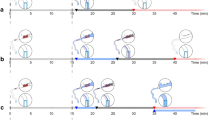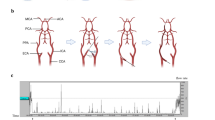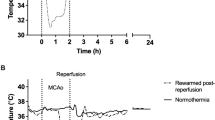Abstract
Local hypothermia induced by intra-arterial infusion of cold saline reduces brain injury in ischemic stroke. Administration of magnesium sulfate through the internal carotid artery is also known to reduce ischemic brain damage. The neuroprotective effects of combination therapy with local endovascular hypothermia and intra-carotid magnesium sulfate infusion has not been evaluated. The aim of the study was to determine whether infusion of intra-carotid cold magnesium offers neuroprotective efficacy superior to cold saline infusion alone. Sixty-eight Sprague–Dawley rats were subjected to 3 h of middle cerebral artery occlusion and were randomly divided into six groups: sham-operated group; stroke control group; local cold magnesium infusion group; local cold saline infusion group; local normothermic magnesium infusion group; and local normothermic saline infusion group. Before reperfusion, ischemic rats received local infusion or no treatment. Infarct volume, neurological deficit, and brain water content were evaluated at 48 h after reperfusion. Selective brain hypothermia (33–34 °C) was successfully induced by intra-carotid cold infusion. Local cold saline infusion and local cold magnesium infusion reduced the infarct volumes by 48 % (p < 0.001) and 65 % (p < 0.001), respectively, compared with stroke controls. Brain water content was decreased significantly in animals treated with local cold magnesium infusion. Furthermore, the rats given a local cold magnesium infusion had the best neurological outcome. Local normothermic infusion failed to improve ischemic brain damage. These data suggest that local hypothermia induced by intra-carotid administration of cold magnesium is more effective in reducing acute ischemic damage than infusion of cold saline alone.



Similar content being viewed by others
References
Dirnagl U, Iadecola C, Moskowitz MA (1999) Pathobiology of ischaemic stroke: an integrated view. Trends Neurosci 22:391–397
van der Worp HB, Macleod MR, Kollmar R (2010) Therapeutic hypothermia for acute ischemic stroke: ready to start large randomized trials? J Cereb Blood Flow Metab 30:1079–1093
Maher J, Hachinski V (1993) Hypothermia as a potential treatment for cerebral ischemia. Cerebrovasc Brain Metab Rev 5:277–300
Zhao H, Steinberg GK, Sapolsky RM (2007) General versus specific actions of mild-moderate hypothermia in attenuating cerebral ischemic damage. J Cereb Blood Flow Metab 27:1879–1894
Kammersgaard LP, Rasmussen BH, Jorgensen HS, Reith J, Weber U, Olsen TS (2000) Feasibility and safety of inducing modest hypothermia in awake patients with acute stroke through surface cooling: a case–control study: the Copenhagen stroke study. Stroke 31:2251–2256
Schwab S, Schwarz S, Spranger M, Keller E, Bertram M, Hacke W (1998) Moderate hypothermia in the treatment of patients with severe middle cerebral artery infarction. Stroke 29:2461–2466
Schwab S, Georgiadis D, Berrouschot J, Schellinger PD, Graffagnino C, Mayer SA (2001) Feasibility and safety of moderate hypothermia after massive hemispheric infarction. Stroke 32:2033–2035
Georgiadis D, Schwarz S, Kollmar R, Schwab S (2001) Endovascular cooling for moderate hypothermia in patients with acute stroke: first results of a novel approach. Stroke 32:2550–2553
Nelson DA, Nunneley SA (1998) Brain temperature and limits on transcranial cooling in humans: quantitative modeling results. Eur J Appl Physiol Occup Physiol 78:353–359
Corbett RJ, Laptook AR (1998) Failure of localized head cooling to reduce brain temperature in adult humans. Neuroreport 9:2721–2725
Wang H, Olivero W, Lanzino G, Elkins W, Rose J, Honings D, Rodde M, Burnham J, Wang D (2004) Rapid and selective cerebral hypothermia achieved using a cooling helmet. J Neurosurg 100:272–277
Neimark MA, Konstas AA, Choi JH, Laine AF, Pile-Spellman J (2007) Local control of temperature in a theoretical human model of selective brain cooling. Conf Proc IEEE Eng Med Biol Soc 2007:6349–6352
Konstas AA, Neimark MA, Laine AF, Pile-Spellman J (2007) A theoretical model of selective cooling using intracarotid cold saline infusion in the human brain. J Appl Physiol 102:1329–1340
Slotboom J, Kiefer C, Brekenfeld C, Ozdoba C, Remonda L, Nedeltchev K, Arnold M, Mattle H, Schroth G (2004) Locally induced hypothermia for treatment of acute ischaemic stroke: a physical feasibility study. Neuroradiology 46:923–934
Neimark MA, Konstas AA, Laine AF, Pile-Spellman J (2007) Integration of jugular venous return and circle of Willis in a theoretical human model of selective brain cooling. J Appl Physiol 103:1837–1847
Ding Y, Li J, Luan X, Lai Q, McAllister JP 2nd, Phillis JW, Clark JC, Guthikonda M, Diaz FG (2004) Local saline infusion into ischemic territory induces regional brain cooling and neuroprotection in rats with transient middle cerebral artery occlusion. Neurosurgery 54:956–964 (discussion 964–955)
Li J, Luan X, Lai Q, Clark JC, McAllister JP 2nd, Fessler R, Diaz FG, Ding Y (2004) Long-term neuroprotection induced by regional brain cooling with saline infusion into ischemic territory in rats: a behavioral analysis. Neurol Res 26:677–683
Colbourne F, Corbett D, Zhao Z, Yang J, Buchan AM (2000) Prolonged but delayed postischemic hypothermia: a long-term outcome study in the rat middle cerebral artery occlusion model. J Cereb Blood Flow Metab 20:1702–1708
Colbourne F, Li H, Buchan AM (1999) Indefatigable CA1 sector neuroprotection with mild hypothermia induced 6 hours after severe forebrain ischemia in rats. J Cereb Blood Flow Metab 19:742–749
Nito C, Kamiya T, Ueda M, Arii T, Katayama Y (2004) Mild hypothermia enhances the neuroprotective effects of FK506 and expands its therapeutic window following transient focal ischemia in rats. Brain Res 1008:179–185
Coimbra C, Drake M, Boris-Moller F, Wieloch T (1996) Long-lasting neuroprotective effect of postischemic hypothermia and treatment with an anti-inflammatory/antipyretic drug. Evidence for chronic encephalopathic processes following ischemia. Stroke 27:1578–1585
Muir KW (2001) Magnesium for neuroprotection in ischaemic stroke: rationale for use and evidence of effectiveness. CNS Drugs 15:921–930
Marinov MB, Harbaugh KS, Hoopes PJ, Pikus HJ, Harbaugh RE (1996) Neuroprotective effects of preischemia intraarterial magnesium sulfate in reversible focal cerebral ischemia. J Neurosurg 85:117–124
Lee EJ, Lee MY, Chang GL, Chen LH, Hu YL, Chen TY, Wu TS (2005) Delayed treatment with magnesium: reduction of brain infarction and improvement of electrophysiological recovery following transient focal cerebral ischemia in rats. J Neurosurg 102:1085–1093
Kaya M, Gulturk S, Elmas I, Kalayci R, Arican N, Kocyildiz ZC, Kucuk M, Yorulmaz H, Sivas A (2004) The effects of magnesium sulfate on blood-brain barrier disruption caused by intracarotid injection of hyperosmolar mannitol in rats. Life Sci 76:201–212
Campbell K, Meloni BP, Knuckey NW (2008) Combined magnesium and mild hypothermia (35 degrees C) treatment reduces infarct volumes after permanent middle cerebral artery occlusion in the rat at 2 and 4, but not 6 h. Brain Res 1230:258–264
Zhu H, Meloni BP, Bojarski C, Knuckey MW, Knuckey NW (2005) Post-ischemic modest hypothermia (35 degrees C) combined with intravenous magnesium is more effective at reducing CA1 neuronal death than either treatment used alone following global cerebral ischemia in rats. Exp Neurol 193:361–368
Longa EZ, Weinstein PR, Carlson S, Cummins R (1989) Reversible middle cerebral artery occlusion without craniectomy in rats. Stroke 20:84–91
Chen J, Sanberg PR, Li Y, Wang L, Lu M, Willing AE, Sanchez-Ramos J, Chopp M (2001) Intravenous administration of human umbilical cord blood reduces behavioral deficits after stroke in rats. Stroke 32:2682–2688
Lin TN, He YY, Wu G, Khan M, Hsu CY (1993) Effect of brain edema on infarct volume in a focal cerebral ischemia model in rats. Stroke 24:117–121
Nishi H, Watanabe T, Sakurai H, Yuki S, Ishibashi A (1989) Effect of MCI-186 on brain edema in rats. Stroke 20:1236–1240
Zhu HD, Martin R, Meloni B, Oltvolgyi C, Moore S, Majda B, Knuckey N (2004) Magnesium sulfate fails to reduce infarct volume following transient focal cerebral ischemia in rats. Neurosci Res 49:347–353
Ding Y, Li J, Rafols JA, Phillis JW, Diaz FG (2002) Prereperfusion saline infusion into ischemic territory reduces inflammatory injury after transient middle cerebral artery occlusion in rats. Stroke 33:2492–2498
Ding Y, Yao B, Zhou Y, Park H, McAllister JP 2nd, Diaz FG (2002) Prereperfusion flushing of ischemic territory: a therapeutic study in which histological and behavioral assessments were used to measure ischemia-reperfusion injury in rats with stroke. J Neurosurg 96:310–319
Grubbs RD, Maguire ME (1987) Magnesium as a regulatory cation: criteria and evaluation. Magnesium 6:113–127
Kollmar R, Schellinger PD, Steigleder T, Kohrmann M, Schwab S (2009) Ice-cold saline for the induction of mild hypothermia in patients with acute ischemic stroke: a pilot study. Stroke 40:1907–1909
Bernard S, Buist M, Monteiro O, Smith K (2003) Induced hypothermia using large volume, ice-cold intravenous fluid in comatose survivors of out-of-hospital cardiac arrest: a preliminary report. Resuscitation 56:9–13
Polderman KH, Rijnsburger ER, Peerdeman SM, Girbes AR (2005) Induction of hypothermia in patients with various types of neurologic injury with use of large volumes of ice-cold intravenous fluid. Crit Care Med 33:2744–2751
Author information
Authors and Affiliations
Corresponding author
Rights and permissions
About this article
Cite this article
Song, W., Wu, YM., Ji, Z. et al. Intra-carotid cold magnesium sulfate infusion induces selective cerebral hypothermia and neuroprotection in rats with transient middle cerebral artery occlusion. Neurol Sci 34, 479–486 (2013). https://doi.org/10.1007/s10072-012-1064-3
Received:
Accepted:
Published:
Issue Date:
DOI: https://doi.org/10.1007/s10072-012-1064-3




